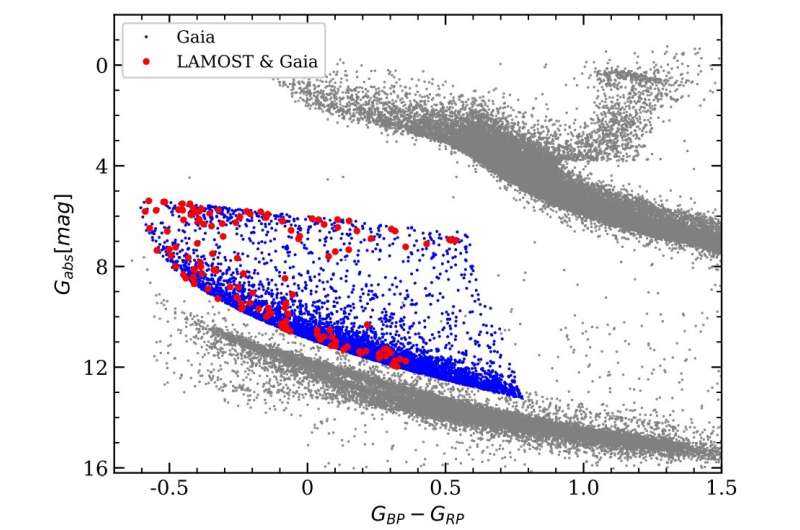Gaia color-magnitude diagram showing ELM WD candidates selected from the Gaia. Credit: Wang et al., 2022.
Using data from the Large Sky Area Multi-Object Fiber Spectroscopic Telescope (LAMOST) and ESA's Gaia satellite, astronomers have detected 21 new high-probability extremely low-mass white dwarfs. The finding is reported in a paper published July 27 on the arXiv pre-print server.
Extremely low-mass (ELM) white dwarfs (WDs) are rare objects, found with only few exceptions in short-period binaries. In ELM WD binaries, one of the stars has a mass lower than 0.3 solar masses. It is assumed that such a low mass cannot be a result of canonical single-star evolution; therefore, these systems are thought to undergo significant mass loss during their evolution.
To date, only about 100 ELM WDs are known, so finding new ones and studying them in detail could be essential to advance knowledge of stellar evolution. Some systems of this type are also predicted to emit gravitational waves, and could hence shed more light on the nature of this phenomenon.
Now, a team of astronomers led by Kun Wang of China West Normal University in Nanchong, China, reports the discovery of 21 new ELM WDs by investigating more than 100 known candidate objects of this type.
"Based on the LAMOST DR8 spectral database, we analyzed 136 ELM WD candidates selected from Gaia DR2 data and 12 known objects previously identified by the ELM Survey," the researchers wrote in the paper.
All in all, Wang's team inspected a total of 188 LAMOST low-resolution spectra, 172 of which belong to 136 ELM WD candidates and 16 of which come from 12 previously known samples. They obtained atmospheric parameters and radial velocities (RVs) for each of the 188 LAMOST spectra. The results indicate a large variety of stars for all the 136 ELM WD candidates, most of which may be hot subdwarf stars or canonical white dwarfs.
The study identified 21 new high-probability ELM WDs with masses below 0.3 solar masses and parallax estimates that agree to within a factor of three. Two of the newfound ELM WD candidates, designated J0338+4134 and J1129+471, exhibit significant RV variability and the researchers suppose that they are very likely binary systems containing at least one ELM WD. J0338+4134 and J1129+471 are also the only two new high-probability ELM WDs that have more than one spectrum.
Moreover, the astronomers found that J0338+4134 showcases a relatively high projected rotation, which may be the result of rotation, line blending, or orbital smearing. However, further high-resolution follow-up spectroscopic observations are required to confirm this finding.
The authors of the paper noted that their study demonstrates the potential of using LAMOST to search for and investigate new ELM WD.
"LAMOST RVs from multiple epochs will allow us to confirm their nature as ELM WDs and obtain their physical parameters," they concluded.
More information: Kun Wang et al, Extremely low-mass white dwarf stars observed in Gaia DR2 and LAMOST DR8. arXiv:2207.13401v1 [astro-ph.SR], arxiv.org/abs/2207.13401
© 2022 Science X Network
























